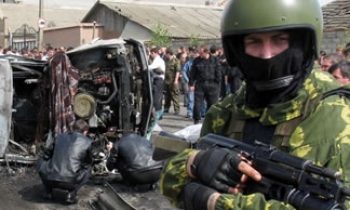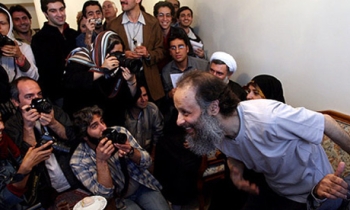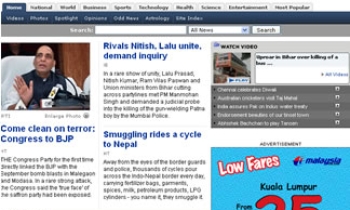It is a newspaper with a circulation of only 20,000 copies, and having online and cable television operations, in the middle of a cornfield in the state of Kansas in the US, which provides a classic case study for newspaper publishers incorporating elements of the practical convergence philosophy into their operations.

The Lawrence Journal-World's websites draw millions of unique visitors per month. Each journalist at this US company — 19 in cable television, 48 in newspaper, 10 in online journalism, and 29 in community journalism — is cross-trained. That means that print reporters can write and present on Lawrence's Channel 6 News and can produce for the website. Television reporters can write text for newspapers and online.
The Lawrence Journal-World instance is cited in A Guide to Practical Convergence: What Every Media Company Must Know About Their Future, recently published by the International Newspaper Marketing Association (INMA). The report examines how newspaper publishers can transform their organisations to reach consumers anytime, anyplace through the integration of print, online, television, and other operations.
The new report has been authored by Martha L Stone, an Internet journalist turned internet consultant who today specialises in convergence. She is the special projects manager for the World Association of Newspapers (WAN)' "Shaping the Future of the Newspaper" project. Stone is also the founding training director for Ifra's Newsplexes Worldwide.
Cross-training at Lawrence Journal-World means photographers become videographers and create slideshows and multi-media presentations for the company's website. Many journalists receive their training on-the-job. Journalists carry mobile phones equipped with cameras. According to Chief Operating Officer Ralph Gage, the first photos taken at accident scenes are sometimes mobile phone photos transmitted to editors to put on the website.
Sometimes the lowresolution pictures are even used as single-column photos in the newspaper. "As our people are becoming more comfortable and intrigued with technology enabling them to communicate with them in new ways, eventually it will be second nature."
Breaking news continues to be a top priority for LJWorld.com, and its sister website KUSports.com reports the scores after each Kansas University football goal and basketball point. Interviews with the coach and players are posted as digital files within a half-hour after the game is over. Lawrence Journal-World newspaper and television reporters write stories and columns for the website, while newspaper photographers contribute 20-30 photos per game for the photo galleries.
Having a small staff and small budget mean making the best of what they can afford. Instead of fancy audio equipment, reporters use basic Radio Shack tape recorders, about US$30 each, to capture audio interviews. Sometimes sound bytes are digitised with free audio editing software called Audacity and used online as audio clips.
The Lawrence operation uses a homegrown content management technology called Ellington to automate content distribution on multiple channels, including print, online, mobile, and mp3 players. The content management system is based on a Python Web framework called Django, developed by Adrian Holovaty first for the Lawrence group of websites and now for a variety of other companies, including EW Scripps. News can be published from newspaper to online, mobile, or mp3 players with little human intervention.

The advertising side of the Lawrence operation has also followed the convergence path. Revenues for online advertising have hovered around US$900,000 for 2004 and for 2005, Gage said, just on the cusp of profitability each year. The Top Ads programme has become a tremendous moneymaker in Lawrence. Locally, it brought in about US$100,000 in 2005.
TopAds are the classified advertisements for jobs, homes, and cars, which have been "upsold" for publication on the home page of the newspaper web site. The text ad either rotates with other ads, or is grouped with other TopAds and does not rotate. The clickable link takes the reader to the classifieds section of the website. TopAds-type strategies have become lucrative for many media companies around the world.
The LJWorld.com website is "dayparted," which means it morphs from a news-oriented website in the morning, to one whose focus tilts towards entertainment information in the late afternoon when people are preparing to leave work and seek after-hours respite at restaurants, pubs, theatres, and other entertainment venues. The afternoon edition is called the "Sundown Edition."
The family of websites is vastly more popular than the parent Lawrence Journal-World print newspaper in terms of circulation. The newspaper circulation is about 20,000 copies per day, while the website gets millions of page views per day. The LJWorld.com website is the most popular, with 10 million to 20 million page views per day, while the KUSports.com typically gets slightly fewer page views, although this can vary on the success of the basketball and football teams. Lawrence.com garners about 2 million to 3 million page views. The statistics are a valuable tool to show advertisers the power of online advertising to such a large Internet audience.
NordJyske Medier, Aalborg, Denmark has changed its newsroom's organisational structure to allow converged journalism to be produced more efficiently and skillfully. The multi-media newsroom is organised by content subjects like sports, news, entertainment, and business — not by media channels. In both Lawrence and Aalborg, groups of journalists are organised into multimedia teams to cover sports, news, culture/entertainment, and business. Each team has crosstrained journalists with capabilities to tell stories in video, audio, and text. As time goes on, the journalists consider themselves just journalists, and not "newspaper journalists" or "television journalists."
This content-oriented organisational method has allowed the news companies to tell stories in new ways and on deadline more quickly and efficiently. "The content approach is better than the media approach. It's better because it removes your head from media, you don't see journalists from other media as competitors. It's the story you are doing, not the media," said Ulrik Haagerup, editor in chief of the multi-media operations.
NordJyske Medier operates a crossmedia advertising department as well. Each of the sales representatives sells cross-media packages covering the range of the company's offerings, and each member of the sales team is trained in selling each medium. The strategy was launched in 2001, after the company was bleeding in circulation and profits during the worldwide advertising downturn.

Newspaper sales, thereafter, increased 33 percent between 2002 and 2005, since NordJyske Medier launched the integrated sales packages. In 2001, total sales were 614 million Danish Kroner (DKK), or about US$100 million, and in 2004, the total sales were 760 million DKK, or about US$123 million. For 2006, Poulsen projects 965 million DKK in sales, or about US$155.5 million. The multiple sources of revenues have been a hedge against advertising downturns, like the downturn of 2000-01. "Multiple revenue streams are a practical formula for the future, especially as newspaper advertising revenues are in decline," Sales Director Jens Poulsen, said.
The INMAs report, which also includes case studies from Naples Daily News, Aftonbladet, Asahi Shimbun, Verdens Gang (VG), Ringkjøbing AMTS Dagblad, Tampa Tribune, and De Volkskrant, simplifies and clarifies the strategies newspaper companies are pursuing to incorporate a broad spectrum of media avenues into a cohesive whole designed to meet audiences' information needs throughout the day. It does so by exploring the four key areas of a news organisation's operations that practical convergence initiatives can impact:
- The company's audience focus strategies.
- The organisation of the newsroom, marketing, and advertising departments.
- The publisher's operations and workflow processes.
- The attitudes and culture of company management.
And, as Stone concludes, " Audience focus is the future. Convergence is the route that will take your company there."









